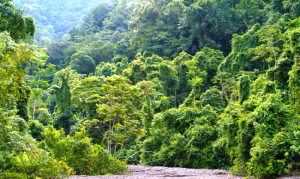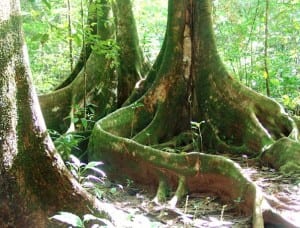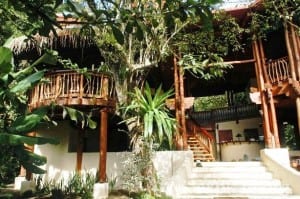 Down in the very south of Costa Rica there is a rainforest you dream to see. Thankfully off the tourism “superhighway” and explored only by adventurous intrepid travelers, it is a place of rugged mountains, plunging waterfalls, free-flowing rivers, striking beaches and magnificent towering trees in dense rainforest.
Down in the very south of Costa Rica there is a rainforest you dream to see. Thankfully off the tourism “superhighway” and explored only by adventurous intrepid travelers, it is a place of rugged mountains, plunging waterfalls, free-flowing rivers, striking beaches and magnificent towering trees in dense rainforest.
Jaguars roam freely, scarlet macaws soar overhead, and humpback whales and dolphins splash in the calm blue waters of the Golfo Dulce in this wilder side of Costa Rica. There aren’t many roads, and there are far more trees than people.
 In the southwestern corner of this peaceful Central American nation, renowned for eco-tourism, the Piedras Blancas National Park is much less visited than its famous neighbor, the Corcovado National Park. One third smaller, the Piedras Blancas National Park spans 34,642 acres that tie into the more than 366,000 acres of land and sea protected in national parks, wildlife refuges and private reserves on the Osa Peninsula Costa Rica.
In the southwestern corner of this peaceful Central American nation, renowned for eco-tourism, the Piedras Blancas National Park is much less visited than its famous neighbor, the Corcovado National Park. One third smaller, the Piedras Blancas National Park spans 34,642 acres that tie into the more than 366,000 acres of land and sea protected in national parks, wildlife refuges and private reserves on the Osa Peninsula Costa Rica.
Sandwiched between the Golfito National Wildlife Refuge to the east and the Golfo Dulce Forest Reserve to the west, Piedras Blancas was heavily logged and hunted until land was donated or slowly bought by charitable groups and turned over for public use. The national park was created in 1993.
 Today, the park protects the remaining lowland tropical rainforest near the Golfo Dulce, and provides a habitat for all five species of Costa Rica wild cats – jaguars, ocelots, margays, jaguarundis and pumas – and all four kinds of monkeys – spider, howler, white-faced capuchin and endangered squirrel monkeys. The park is considered to be one of the top bird-watching locations in Costa Rica, with more than 330 species recorded.
Today, the park protects the remaining lowland tropical rainforest near the Golfo Dulce, and provides a habitat for all five species of Costa Rica wild cats – jaguars, ocelots, margays, jaguarundis and pumas – and all four kinds of monkeys – spider, howler, white-faced capuchin and endangered squirrel monkeys. The park is considered to be one of the top bird-watching locations in Costa Rica, with more than 330 species recorded.
 The best way to visit Piedras Blancas National Park is to stay in the area. Playa Nicuesa Rainforest Lodge is the top Costa Rica eco-lodge on the Golfo Dulce. Its 165-acre private preserve backs into the Piedras Blancas National Park. While visiting, you can explore thriving rainforests and immaculate beaches, powerful waterfalls and the fascinating Esquinas River and mangrove estuary. Just off the coast are many intact coral reefs, providing excellent places to snorkel and swim.
The best way to visit Piedras Blancas National Park is to stay in the area. Playa Nicuesa Rainforest Lodge is the top Costa Rica eco-lodge on the Golfo Dulce. Its 165-acre private preserve backs into the Piedras Blancas National Park. While visiting, you can explore thriving rainforests and immaculate beaches, powerful waterfalls and the fascinating Esquinas River and mangrove estuary. Just off the coast are many intact coral reefs, providing excellent places to snorkel and swim.
Article by Shannon Farley
Comments